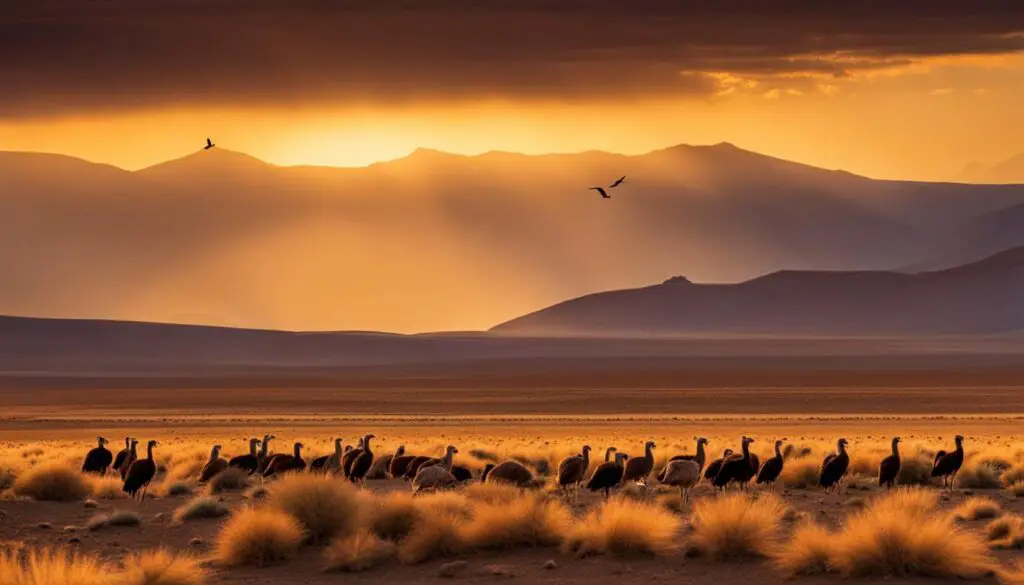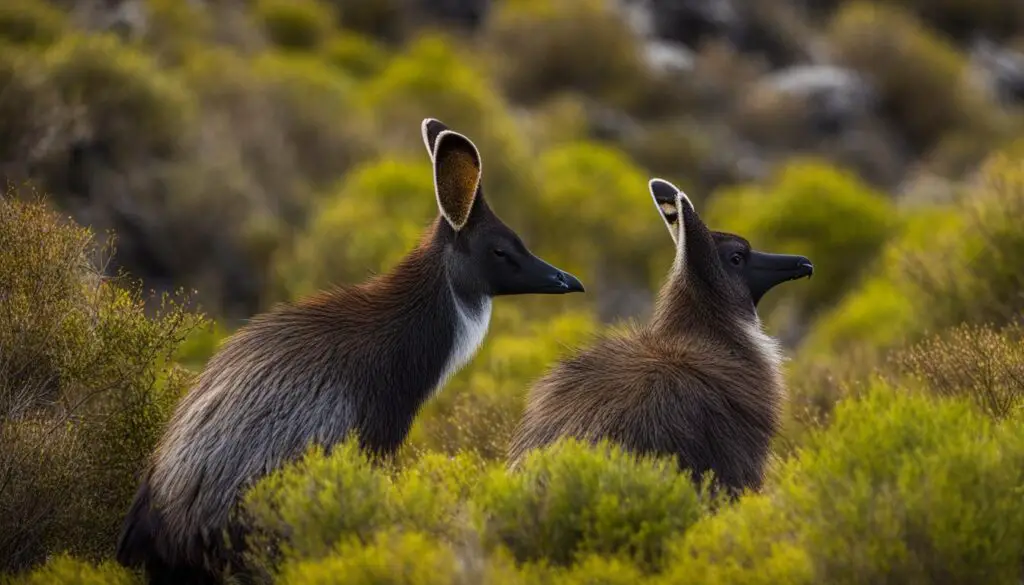Chile is a country known for its breathtaking landscapes and rich biodiversity. From the majestic Andes mountains to the picturesque Pacific coastline, the diverse geography of Chile provides a multitude of habitats for a wide range of animal species.
When it comes to wildlife, Chile boasts an impressive array of native animals that are found nowhere else in the world. This unique fauna includes both iconic and endangered species, making Chile a hotspot for animal enthusiasts and nature lovers alike.
Exploring the animal kingdom in Chile reveals fascinating creatures that have adapted to their specific environments over time. From the soaring Andean condor to the elusive South Andean huemul, each species contributes to the rich tapestry of Chile’s wildlife.

Key Takeaways:
- Chile’s diverse geography provides a range of habitats for a wide variety of animal species.
- Chile is home to unique and endemic animals found nowhere else in the world.
- Conservation efforts are crucial for protecting Chile’s native fauna and preserving biodiversity.
- The Andean condor and South Andean huemul are two iconic animal species in Chile.
- Exploring Chile’s wildlife offers a glimpse into the country’s rich natural heritage.
Notable Animal Species in Chile
Chile is known for its remarkable wildlife and is home to several notable animal species. From majestic birds of prey to unique deer species, Chilean wildlife showcases a diverse range of endemic and fascinating creatures.
One of the most iconic animals in Chile is the Andean condor, a large bird of prey that soars through the skies of the Andes mountains. With a wingspan of up to 10 feet, the Andean condor is not only an impressive sight but also holds the title of being the national bird of Chile. Its graceful flight and distinctive appearance make it a symbol of the country’s rich biodiversity.
The South Andean huemul is another notable species found in Chile. As the national animal, it represents the unique wildlife of the country. This deer species is endemic to Chile and can be found in the southern regions of the country. With its striking appearance and presence in Chilean folklore, the South Andean huemul holds a special place in the hearts of Chileans as a symbol of their natural heritage.
Chile is also home to other unique animals that further emphasize its exceptional biodiversity. The Pudú, recognized as the world’s smallest deer, resides in the temperate rainforests of southern Chile. This adorable creature, standing at just 14 to 17 inches tall, is a testament to the incredible variety of fauna that thrives in Chile’s diverse ecosystems.
Another fascinating species in Chile is the Guanaco, a member of the camelid family. These graceful animals can be found roaming the open grasslands and mountainous regions of Chile. Known for their slender build and ability to withstand harsh climates, Guanacos are an integral part of the Chilean wildlife landscape.
The presence of these notable animal species in Chile highlights the significance of wildlife conservation efforts in the country. Protecting their habitats and preserving the unique biodiversity not only ensures the survival of these remarkable creatures but also contributes to the overall ecological balance.
Protected Areas and Conservation in Chile
Chile takes great pride in its commitment to conservation and environmental protection. With 100 protected areas covering 20% of the country’s land, including national parks, reserves, and monuments, Chile is dedicated to preserving its rich biodiversity and unique ecosystems. These protected areas serve as havens for the diverse flora and fauna that call Chile home.
One remarkable example is the Valdivian forests, a temperate rainforest in southern Chile known for its exceptional biodiversity and stunning landscapes. This forest is home to over 50% of Chile’s endemic flora, making it a critical area for biodiversity conservation.
The creation and management of protected areas in Chile are overseen by government agencies such as the Chilean Forest Service (CONAF) as well as private organizations. Their collaborative efforts ensure the effective safeguarding of Chile’s natural heritage for future generations.
These protected areas not only provide sanctuary for wildlife but also contribute to scientific research, education, and ecotourism, promoting a greater understanding and appreciation for Chile’s natural wonders.

Conservation efforts in Chile extend beyond protected areas, with various initiatives in place to promote sustainable development and environmental stewardship. The government, along with non-governmental organizations and local communities, continually works to balance economic growth with the preservation of natural resources and ecosystems.
Through sustainable practices, such as responsible tourism, sustainable agriculture, and renewable energy projects, Chile strives to mitigate the impact of human activities on the environment, ensuring the long-term viability of its natural treasures.
Wildlife Habitats in Chile
The diverse geographical features of Chile provide a range of habitats for wildlife. From the Andes mountains to the coastal areas and even the Atacama Desert, Chile is home to a variety of ecosystems that support a rich array of animal species.
Andes Mountain Wildlife
The majestic Andes mountains in Chile are not only a breathtaking sight but also a habitat for various wildlife species. One of the most iconic animals found in this region is the Andean condor, a magnificent bird of prey. With its impressive wingspan, the Andean condor soars through the mountains, symbolizing the beauty and power of Chilean wildlife. Another notable species in the Andes mountains is the South Andean huemul, which is the national animal of Chile. This deer species is endemic to the country and thrives in the mountainous terrain.
Coastal Wildlife Chile
The coastal areas of Chile are home to a diverse marine ecosystem, supporting a wide range of wildlife. Penguins, such as the Humboldt penguin, can be found along the shores of Chile, waddling and swimming in the cold waters. Flamingos are another beautiful sight along the coast, with their vibrant pink feathers contrasting against the blue of the ocean. The coastal regions provide essential feeding and breeding grounds for these and other species, making them vital habitats for Chilean wildlife.
Wildlife in the Atacama Desert
The Atacama Desert, known as the driest desert in the world, may seem inhospitable, but it is home to unique desert wildlife that has adapted to survive in harsh conditions. Cacti, such as the Copiapoa and the Eriosyce, thrive in the arid environment, with their spiky exteriors protecting them from the scorching sun. Lizards, such as the Atacama desert iguana and the Liolaemus lizard, can also be found in this desert ecosystem. These resilient species showcase the incredible ability of wildlife to adapt and thrive in even the most challenging environments.

The different regions of Chile, from the north with its harsh desert climate to the south with its temperate rainforests, offer a wide array of habitats that support a diverse range of animal species. The protection and conservation of these habitats are crucial for preserving Chile’s unique wildlife and ensuring their survival for future generations.
| Region | Wildlife Habitats |
|---|---|
| Andes Mountains | Alpine habitats, mountainous terrain |
| Coastal Areas | Beaches, rocky shores, marine ecosystems |
| Atacama Desert | Arid landscapes, desert ecosystems |
| North | Desert climate, oasis habitats |
| Central | Valleys, Mediterranean climate |
| South | Temperate rainforests, fjords |
Conclusion
Chile is a country blessed with a remarkable range of wildlife, showcasing its immense biodiversity. From the majestic Andean condor soaring high in the sky to the adorable Pudú, the world’s smallest deer, Chile is home to unique and endemic animal species that capture the imagination and fascination of nature lovers.
The conservation efforts in Chile play a vital role in preserving and protecting these precious animal species and their habitats. The establishment of protected areas, including national parks, reserves, and monuments, reflects the country’s commitment to safeguarding its natural heritage. Through these conservation initiatives, Chile is ensuring that its diverse animal kingdom can thrive and flourish for generations to come.
By prioritizing conservation and environmental protection, Chile demonstrates its dedication to preserving the rich biodiversity found within its landscapes. The unique ecosystems, such as the Valdivian forests and the coastal marine ecosystems, are precious treasures that require ongoing stewardship. Through sustainable practices and collaborative efforts between government agencies and private organizations, Chile is poised to continue serving as a sanctuary for its remarkable wildlife.
In conclusion, Chile stands as a shining example of a country that values and celebrates its diverse animal kingdom. The iconic Andean condor, the mighty South Andean huemul, and countless other remarkable species find a haven in this nation. As Chile moves forward, its commitment to conservation will ensure that its landscapes remain teeming with life, providing a sanctuary for the animals that call it home.
FAQ
What kind of animals can be found in Chile?
Chile is home to a diverse range of animal species, including the national bird, the Andean condor, and the national animal, the South Andean huemul. Other notable animals in Chile include the Pudú, the world’s smallest deer, and the Guanaco, a member of the camelid family.
Are there any endangered animals in Chile?
Yes, there are several endangered species in Chile, including the South Andean huemul and the Andean condor. These endangered animals highlight the importance of conservation efforts in Chile to protect their habitats.
How many protected areas are there in Chile?
Chile has 100 protected areas, including national parks, reserves, and monuments, which cover 20% of the country’s land. These protected areas are crucial for preserving the diverse flora and fauna of Chile.
Who oversees the creation and management of protected areas in Chile?
The creation and management of protected areas in Chile are overseen by government agencies such as the Chilean Forest Service (CONAF) and private organizations dedicated to conservation.
What kind of wildlife habitats can be found in Chile?
Chile’s diverse geographical features provide a range of habitats for wildlife. The Andes mountains are home to various species, including the Andean condor and the South Andean huemul. The coastal areas of Chile support a rich marine ecosystem with species like penguins and flamingos. The Atacama Desert, known as the driest desert in the world, is home to unique desert wildlife such as cacti.
